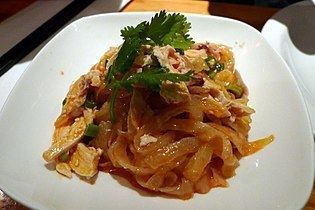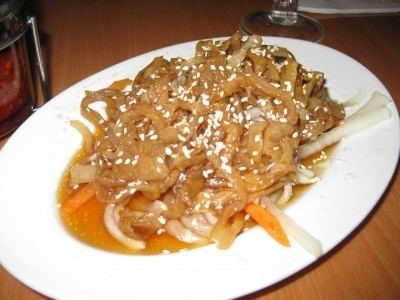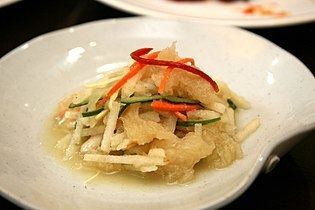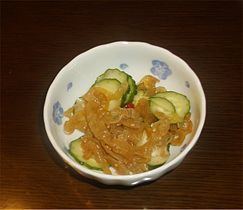 | ||
Similar Herring as food, Marine mammals as food, Shark meat, Fermented fish, Fish steak | ||
Some species of jellyfish are suitable for human consumption and are used as a source of food and as an ingredient in various dishes. Edible jellyfish is a seafood that is harvested and consumed in several Asian and Southeast Asian countries, and in some Asian countries it is considered to be a delicacy. Edible jellyfish is often processed into a dried product. Several types of foods and dishes may be prepared with edible jellyfish, including salads, sushi, noodles, main courses, and even ice cream. Various preparation methods exist.
Contents

Edible jellyfish

In China, some species of jellyfish in the Rhizostomae order caught in coastal areas have been utilized as a source of food and ingredient in Chinese cuisine for over 1,700 years. Cannonball jellyfish (Stomolophus meleagris) and jelly blubber (Catostylus mosaicus) are edible species of jellyfish. Of note is that when live, the cannonball jellyfish contains toxins that can cause cardiac problems in animals (including humans). Rhopilema esculentum and Rhopilema hispidium are edible jellyfish, and are the most common ones consumed in China, Japan and Korea. Additional edible jellyfish species include Aurelia aurita, C. orsini, Dactylometra pacifica, Hispidium spp., Lobonema smithi, Lobonemoides gracilis and Nomura's jellyfish (Stomolophus nomuria). Desalted ready-to-use jellyfish are low in calories and contain hardly any fat, about 5% protein and 95% water. They do not have much flavor, and may be used to add additional texture and mouthfeel to various dishes. In some areas of Asia, jellyfish is "associated with easing bone and muscle pain."
Production

In 2001, the annual global harvest of edible jellyfish was estimated to be around 321,000 metric tons. The most prominent countries involved in edible jellyfish production are Burma, China, Indonesia, Korea, Malaysia, the Philippines and Thailand. In China, jellyfish larvae are reared in ponds before being released as juveniles into the sea to grow and mature. In Southeast Asia, edible species of jellyfish may be harvested using various nets such as drift nets, scoop nets, set nets and hand nets, hooks and beach seines. In 2001, the estimated annual catch in Southeast Asia in net weight was at around 169,000 metric tons. The amount of jellyfish caught annually in this region can vary significantly, and the fishing season for them is relatively short, at two to four months.
Fishing down the food web

The trophic level of an organism is the position it occupies on the food chain. Fisheries have been systematically overfishing high trophic predatory fish. This can result in a process called fishing down the food web, whereby the mean trophic level of available marine organisms decreases and the fishing effort must shift towards lower trophic organisms, such as jellyfish. According to the fisheries scientist Daniel Pauly, if fishing down the food web continues it will in time reduce people to a diet of jellyfish sandwiches and plankton soup.
Processing

Traditional methods of processing jellyfish into a dried food product can take a considerable amount of time, between 19 and 37 days. A common processing technique is the preservation of jellyfish, which may utilize salt curing to accomplish this, creating a dried finished product. Some commercially processed edible jellyfish are purveyed in dried sheets. The process of producing dehydrated jellyfish typically includes the removal of the tentacles prior to drying, because the upper dome area of the marine animal is the part typically used for cooking.
Jellyfish deteriorate rapidly at room temperature so processing starts soon after they are caught. The bell is separated from the dangling oral arms and both are washed in seawater before being scraped to remove the gonads and mucus. Dehydration is traditionally undertaken by sprinkling the jellyfish with table salt and alum, draining off the brine and repeating the process. Finally the jellyfish are heaped to drain, turned several times and left to dry. The whole process takes three to six weeks and results in a product with about 65% moisture and 20% salt. The alum reduces the pH and serves to firm the texture while the salt removes water and prevents microbial deterioration. In Malaysia and Thailand, a little sodium bicarbonate is added during processing which facilitates dehydration and increases crispness.
Consumption
Jellyfish is consumed in several Asian and Southeast Asian countries. In 2001, it was reported that Japan had annually imported between 5,400 and 10,000 tons of edible jellyfish from Indonesia, Malaysia, Myanmar, the Philippines, Singapore, Thailand, and Vietnam. Dehydrated and pickled jellyfish is considered a delicacy in several Asian countries, including China, Korea, Taiwan, Vietnam, and Japan. A preparation method using dehydrated jellyfish involves re-hydrating the product by soaking it in water for several hours and then parboiling, rinsing and slicing it.
Dishes
Jellyfish salad, a popular dish in some areas of Asia, may be prepared using cold marinated jellyfish that is thinly sliced. Some Asian airlines serve jellyfish salad as a part of their airline meal fare. Jellyfish sushi is consumed in Japan. In Thailand, a crunchy style of noodle is produced using jellyfish. The Japanese company Tango Jersey Dairy produces a vanilla and jellyfish ice cream. The ice cream is prepared using Nomura's jellyfish (Echizen kurage in Japanese), and involves soaking cubes of the diced jellyfish in milk. It has been described as "slightly chewy." Another reaction to the 2009 Japanese Nomura's jellyfish bloom, students in the Obama prefecture designed a Nomura Jellyfish powder to be used to make caramel sweets as part of a NASA-designed food safety management system established in the school.
